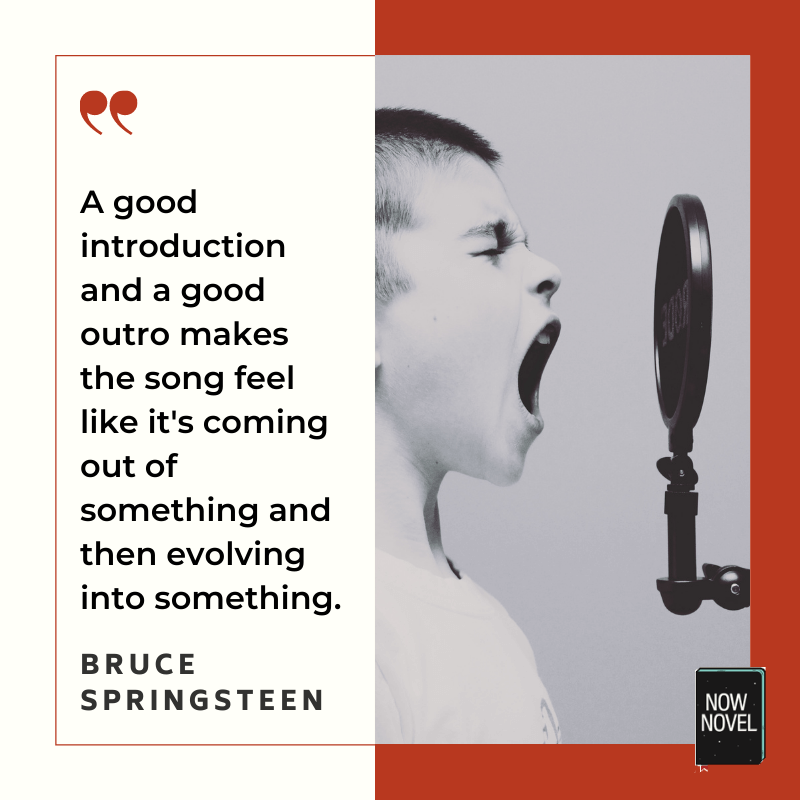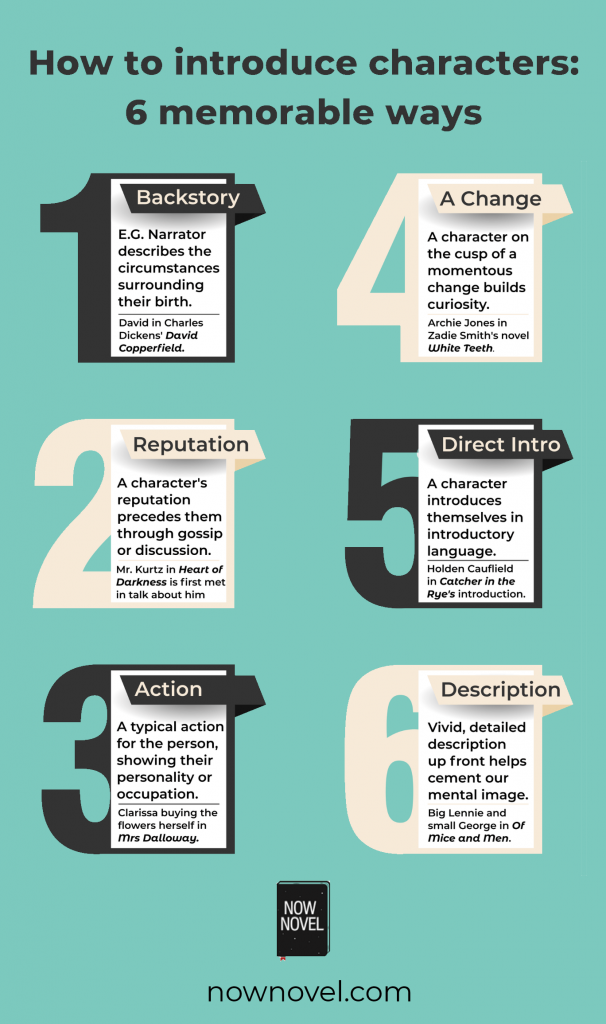Knowing how to introduce characters so that they stick in readers’ minds is a skill. Here are six techniques to create memorable first impressions:
6 ways to introduce your characters:
- Use backstory to reveal relevant character history
- Introduce a character through another POV
- Show typical action
- Introduce a character on the cusp of change
- Make characters introduce themselves directly
- Write a memorable, unique character description
Let’s examine each of these character introduction ideas, with examples:
1: Use backstory to reveal relevant character history
Telling a character’s history gives readers a sense of their formative experiences. A person’s past helps us understand their motivations, their psychology.
If you choose this approach, there’s a caveat: avoid info dumps. Keep backstory relevant to your character’s story arc and their present circumstances.
The opening of Charles Dickens’ David Copperfield is a good example.
Example of backstory introduction: David Copperfield
In Dickens’ autobiography-style story, the narrator introduces himself by telling the reader about the death of his father only six months before his birth:
I was born at Blunderstone, in Suffolk, or ‘there by’, as they say in Scotland. I was a posthumous child. My father’s eyes had closed upon the light of this world six months, when mine opened on it.
Charles Dickens, David Copperfield, p. 4. Full text available here.
This introduction is effective on two levels:
- Due to the tragic and personal nature of David’s backstory, we empathise with the character
- The introduction is relevant – David proceeds to tell of his mother’s remarriage and how he is sent, at his step-father’s insistence, to live with their housekeeper’s family – a significant, key plot point
Dickens thus keeps David’s backstory relevant to core plot developments, while also reeling the reader in with emotive details of personal history.

2: Introduce a character through another POV
As in life, fictional characters’ reputations sometimes precede them.
This is especially true for villains. Showing other characters talking about a dubious character before they arrive builds suspense.
Example of introducing characters via others’ testimony: Heart of Darkness
In Joseph Conrad’s novella about the brutalities of colonization in Africa, Heart of Darkness, Conrad introduces Kurtz (the violent head of an ivory trading-post) in stages.
First, the narrator Marlow hears from a colonial accountant that Kurtz is ill:
There were rumours that a very important station was in jeopardy, and its chief, Mr. Kurtz, was ill. [The accountant] hoped it was not true. Mr. Kurtz was … I felt weary and irritable. Hang Kurtz, I thought. I interrupted him by saying I had heard of Mr. Kurtz on the coast. ‘Ah! So they talk of him down there,’ he murmured to himself. Then he began again, assuring me Mr. Kurtz was the best agent he had, an exceptional man, of the greatest importance to the Company.
Joseph Conrad, Heart of Darkness, p. 30
Conrad builds up to Marlow’s first encounter with Kurtz. After this glowing description, Marlow meets a more impartial Russian adventurer who has met Kurtz.
The Russian paints a more sinister picture:
It was curious to see his mingled eagerness and reluctance to speak of Kurtz. The man filled his life, occupied his thoughts, swayed his emotions. ‘What can you expect?’ he burst out; ‘he came to [the locals] with thunder and lightning, you know – and they had never seen anything like it – and very terrible.
Heart of Darkness, p. 79.
The traveler tells Marlow about a time Kurtz threatened to shoot him if he didn’t hand over a stash of ivory he had poached. Thus we see a darker image of Kurtz’s character before seeing him in person.
Like Conrad, you can introduce a character through others’ perspectives and build suspense.

3: Show a typical action
Introducing characters with actions is simple and effective. We may learn a character’s passions, hobbies, occupation, or another detail relevant to their story.
Example of action-based introduction: Mrs Dalloway
Take, for example, our first encounter with Clarissa Dalloway, the title character of Virginia Woolf’s Mrs. Dalloway:
Mrs. Dalloway said she would buy the flowers herself.
For Lucy had her work cut out for her. The doors would be taken off their hinges; Rumpelmayer’s men were coming. And then, thought Clarissa Dalloway, what a morning – fresh as if issued to children on a beach.Virginia Woolf, Mrs Dalloway, p. 1.
The sense of purpose, the fact Clarissa decides to buy the flowers herself, shows her take-charge nature.
Woolf also shows Clarissa through the perspectives of passersby. Woolf thus combines a typical action for Clarissa (taking pondering walks) with others’ viewpoints (another introduction technique).
For example, Clarissa’s neighbour’s thoughts intrude on the narration:
A charming woman, Scrope Purvis thought her (knowing her as one does know people who live next door to one in Westminster); a touch of the bird about her, of the jay, blue-green, light, vivacious, though she was over fifty, and grown very white since her illness.
Woolf, Mrs Dalloway, pp. 1-2.
Woolf introduces a little backstory (Scrope Purvis’ mention of Clarissa’s illness), incorporating yet another element of introduction (backstory). Yet note how subtly a brief bit of backstory is slipped in.
In the space of two pages, Woolf thus effectively combines several of the ways to write character introductions mentioned in this post.
When you introduce a character, show actions that:
- Illustrate a character’s nature or temperament
- Bring them into contact with others who can flesh out the reader’s impression further
In addition, include clear physical description (by the second page, we know Clarissa has a light, bird-like quality and is over fifty and pale-skinned).

Start profiling your story’s cast
Create detailed character profiles in easy steps so you know who each character is before you introduce them.
START4: Introduce a character on the cusp of change
Showing a person on the cusp of change is one of the suspense-building options among how to introduce characters. .
Showing a character in a dilemma, about to make a life-changing decision, propels your story forwards.
Take Zadie Smith’s introduction of the character Archie Jones in her novel White Teeth.
Example of cusp-of-change introduction: White Teeth
At the start of Zadie Smith’s debut novel, Archie Jones, recently divorced, attempts to kill himself in his car:
Early in the morning, late in the century, Criklewood Broadway. At 06.27 hours on 1 Jannuary 1975, Alfred Archibald Jones was dressed in corduroy and sat in a fume-filled Cavalier Musketeer Estate face down on the steering wheel, hoping the judgement would not be too heavy upon him.
Zadie Smith, White Teeth, p. 3.
This strong introduction conveys Archie’s psychological state, his despair and decision to end his life.
Smith introduces dark humour when Mo, a local halal butcher, interrupts Archie because he’s parked in Mo’s delivery loading bay:
‘Mo advanced upon Archie’s car, pulled out the towels that were sealing the gap in the driver’s window, and pushed it down five inches with brute, bullish force.
“Do you hear that, mister? We’re not licensed for suicides around here. This place is halal. Kosher, understand?’Smith, White Teeth, p. 7.
Through this interaction Smith shows a melting pot of characters in her London setting. We are intrigued, wondering why Archie wants to end his life.

5: Make characters introduce themselves directly
This type of character introduction is particularly common in first person novels where the protagonist is also the narrator.
The narrator Taylor Greer in Barbara Kingsolver’s novel The Bean Trees is one example.
Example of a character introducing themselves: The Bean Trees
The Bean Trees opens thus:
I have been afraid of putting air in a tire ever since I saw a tractor tire blow up and throw Newt Hardbine’s father over the top of the Standard Oil sign. I’m not lying. He got stuck up there. About nineteen people congregated during the time it took for Norman Strick to walk up to the Courthouse and blow the whistle for the volunteer fire department.
Barbara Kingsolver, The Bean Trees, p. 1.
Kingsolver starts with a strong emotion: Fear.
The character introduction conveys Taylor’s rural background by describing an incident involving a tractor.
Over the course of the novel, we learn more about Taylor’s fears (for example, her fear of falling pregnant like many of the girls back home in rural Kentucky).
Taylor has to confront her fears when she finds and adopts an abandoned baby girl. Fear (and overcoming it) is thus central to the novel.
So it’s fitting that at the start of the novel, Taylor recounts a fear-inducing event back home.
When you introduce characters directly, as first-person narrators, make them:
- Reveal their personalities – in Taylor’s case, she is revealed as fearful, a fear she is forced to confront as the story unfolds
- Believable: Taylor’s speech is natural. The way she adds ‘I’m not lying’ to her tall tale adds personality and an element of self-awareness
6: Write a memorable, unique physical description
When introducing characters, give readers the detail they need to picture them.
In John Steinbeck’s Of Mice and Men, we get a precise image of two co-travelers, the central characters.
Example of vivid character introduction via description: Of Mice and Men
Steinbeck introduces the simple, large Lennie and the small, shrewd George with this description:
Both were dressed in denim trousers and in denim coats with brass buttons. Both wore black, shapeless hats and both carried tight blanket rolls slung over their shoulders. The first man was small and quick, dark of face, with restless eyes and sharp, strong features. Every part of him was defined: small, strong hands, slender arms, a thin and bony nose. Behind him walked his opposite, a huge man, shapeless of face, with large, pale eyes, with wide, sloping shoulders; and he walked heavily, dragging his feet a little, the way a bear drags his paws.’
John Steinbeck, Of Mice and Men, p. 8.
Steinbeck’s detailed description begins with George and Lennie’s clothing.
From here, he describes contrasting features, George’s fineness and chiseled face and Lennie’s ‘shapelessness’.
He also describes both with posture and movement. Lennie drags his feet ‘the way a bear drags his paws’.
Shortly after this description, when they reach a clearing, Lennie ‘flings’ himself down, while George steps ‘nervously’.
The way both characters move matches their temperaments and the preceding physical description.
When introducing a character visually, include:
- Identifying dress
- Physical features (their facial features, body type, etc.)
- Any characteristic movement (e.g. Lennie’s bear-like gait)
Start profiling detailed characters the easy way in Now Novel’s outlining dashboard.


33 replies on “How to introduce characters: 6 ways to be memorable”
This was really helpful! I’m in chapter ten in my latest novel and i’ve switched point of view from the good guys to the bad guys, but I did not know how to introduce them in an interesting and significant way. I’ve never had trouble with that before but I was really stuck. This helped a lot! Thank you!
I’m glad to hear that, Mariam. Best of luck for writing the bad guys’ part.
My book just started, and I am introducing two new characters at once, a grown man; a mercenary bowman, and his young charge, a golden-haired little thing who is working to study some old ruins for her master. I have the scene planned and the setting established, but I find myself not knowing how to introduce these characters. His hair was long and black as pitch, he had a short, well-trimmed beard, an average nose, and deep blue eyes. He wore a hood and heavy black padded cloth under thick leather plates. He is standing by the door of the ruins listening to the cave-like echos from the depths (But I dont want to just SAY these things) any help would be nice.
Here’s one possibility, Scott. You could describe this man with the long hair and blue eyes from his young charge’s perspective, the first time they meet. That way you could slip in some of her initial impressions about his character, beyond physical appearance. Hope that helps!
Great post! Have shared..
Thank you, Joanne! Thanks for reading.
Am always fascinated each morning when I get handy tips like this one. Thanks a lot.
It’s a pleasure, thank you for reading and this generous feedback, Maxwell.
I struggled with this having to introduce 6 characters right at the start, they’re a team and all have important backstory that’s revealed one at a time through the course of the story.
I basically went right into physical descriptions.
That is one approach. The danger of launching right in with extensive physical description is it can start to read like a ‘shopping list’ of attributes (‘she had this, and this, and this, and that’). If it works, great! If it’s a little clunky or the author’s hand is too visible, try introducing some through appearance, others through voice (how they sound – dialogue comes in handy here), others through demeanor (is there a shy one, or a brash one?). Good luck!
Thanks! I may try to fix that part later by having each doing or saying something as they enter.
At least for most of the novel, they are not all around together, or I agree that would be a bit too overwhelming of a main cast (they get split up early on and several are absent for much of the story).
This helped me a lot as well. The issue I had with my own story was that I kept trying to start with a single character or with several at once.
I’m using my prologue as a way to “introduce” my main character with a few small personality traits, then using the first chapter as a way to describe him physically.
Hi Ethan, my sincere apologies for the delayed reply, I don’t see notifications for older posts always. I hope your book’s progressed well since you shared this. Thank you for reading!
It’s perfectly fine. I’m currently taking a slight hiatus to try and really break down the details of how I want to start. Decided to start out with a different character, potentially, but that means I gotta work out a new plotline. However, your article here DID help a lot. It’s more of a battle with short-term writers block when trying to start.
Any advice on how to introduce my six characters, if they’re all very important to the plot? Three of them are brothers, and the other three are sisters, so if I choose to introduce one person, I end up having to introduce his brothers ( or sisters ). Is there any other way, or am I doing somthing wrong?
Hi there, I’m sorry for the delay in getting back to you! I don’t always receive comment notifications for some reason. I’m sure you’re further along now, but I don’t see why you couldn’t introduce all the siblings in a shared scene. I’m sure however you’ve approached this it’s effective.
I am currently writing a science fiction novel and have a strong protagonist which has already been introduced. I have written three chapters thus far. My problem is that I need to introduce a new important character who appears much later in the story but has everything to do with the outcome and the fate of the protagonist. Do I introduce her now as a separate character or wait until he( the protagonist) meets her later on. In other words should I keep my story in a more linear style or break it up by introducing her now, but not revealing the future relationship that the two will have?
Hi Mark, sorry for the delay in seeing and responding to your interesting question. You could introduce her in reputation, often characters hear about each other before we actually read scenes focused on the other character’s viewpoint. A non-linear approach also offers fun creative possibilities in terms of narrative structure. I’m sure you’ve found an effective solution! Thanks for reading.
i have a problem in introducing other characters. like how would i describe their personality without using cliches like (winter or ice cold, happy, energetic etc) i want to describe someone who would stick to the reader’s memory and have a unique introduction than others characters. those characters i want to introduce are two brothers, they both have different personality. the eldest is a boy with a few words, his cold, and not ever friendly with anyone. he kinda have this cold-death stare etc. the other is extremely energetic he smiles all the time and he bugs everyone with what they are doing. he is fascinated about everything just like a child. i dont want to give the read all the info at once because that would be confusing and i want to make it memorable. thankyouu.
Hi Wajan,
Thank you for stopping by and sharing this challenge. I would suggest for each brother, focus on crafting a voice and manner corresponding to these personality types you suggested (cold and reserved versus energetic and outgoing). For example, when the cold/held back brother speaks, perhaps he answers in shorter sentences, and asks questions in return less than his brother (is less curious/engaging with others).
Think about how these personalities, in other words, shape everything else about the characters – for example details such as how they dress and look, where they like to spend their time, who they like to spend it with, what their hobbies are. This sort of detail can form an idea of ‘energetic’ or ‘cold’ (in relation to someone’s character) without your ever having to spell out in as many words ‘He was an energetic/cold person’ to the reader.
I hope that makes sense! As an exercise, write a scene where the cold brother is purchasing something at a supermarket that reveals his nature (for example, does he step away when someone stands too close in line, not make eye contact with the person at the counter? And so forth).
yeah i understand, and thank you for the help! it makes a lot of sense now
It’s a pleasure! 🙂
Hi, I’m writing a supernatural novel and I did some research to prepare for it. It was based on what I’ve written when I was in middle school so I wanted to improve it. It’s a series and I was reading clueless before how I should put it so I just wrote them the way I thought was good but now i think they’re too childish. The novel has a wide scope somehow, it consists of different stories in each book- it’s like a series. About four books in total and I’ve decided to rewrite them chronologically…so the first boom would be like the origin thingy and it needs a past/history (setting) and most of the story will take place in the present. I thought I could write a prologue but I’m worried that it won’t be enough to show the back story/history of the protagonist why she is like this in the present so it’s confusing me now how to do it or how to place them together. Plus there are more then three characters that has a big role in he story.
I have not ever sold a book, so I might not be the best advisor, but I’ll offer what I think, and you can ignore it or take it into account or what have you.
I would write it with an overlying plot, but with flashbacks. It doesn’t always work, but as a reader, it’s interesting to have a main character with a mysterious past that gradually grows less and less mysterious as the story progresses. If you don’t want to do that, then a prologue could probably work, or you could do a prequel, but it’s always best to start off with main arc and do the origin story later, speaking in series terms.
I wish you luck on your writing quest.
Thank you. That was my first option and I’m considering that too but I wanted to know if theres any way. Anyway if I read something. I prefer it the way you suggested. I’ll have to write the whole thing first then I’ll see in what way it works best and ask opinions too. Thank you for your suggestion!
Hi Alia,
Thank you for sharing that. I’d suggest writing an outline for each part of the series (including the prologue), describing in brief summary form what you want each portion of the series arc to cover. Good luck!
I’m thinking this way too. I’m starting to write an outline for each series but I can’t decide yet. I want to keep some things mysterious at first and yet I’m trying to see how I make it that way. The more I analyze the outlines I’ve made i think I’m starting to find the best way to deliver the series. Thank you for your advice! I’ll do my best.
How do I introduce two characters from the Protagonists POV. A girl who falls in love with Protagonist and his friend.
Hi Manoj, thank you for reading our article and your question. There are many ways you could introduce both characters. You could do so through:
It’s difficult to advise in much greater detail without knowing more about your story, but I hope this helps.
[…] How To Introduce Characters – Now Novel […]
Ya that’s good
If writing a story about birds squabbling over territory, would it be necessary to give a description of the two characters involved watching the drama unfold?
Hi Helen, thank you for your question.
It’s not strictly necessary to describe the two characters watching the birds squabble, but it can add depth and perspective to the scene. If the characters are central to the story, their reactions to the bird drama can reflect their personalities, emotions, or even mirror a larger conflict in the narrative. For example, you could use their observations to subtly convey tension, curiosity, or amusement, making the scene more than just about the birds—it becomes a moment of character development or symbolism.
On the other hand, if the focus is purely on the birds’ territorial squabble and the characters are more passive observers, you could keep the description minimal, only hinting at their presence without distracting from the main action. It all depends on the role that moment plays in your story.